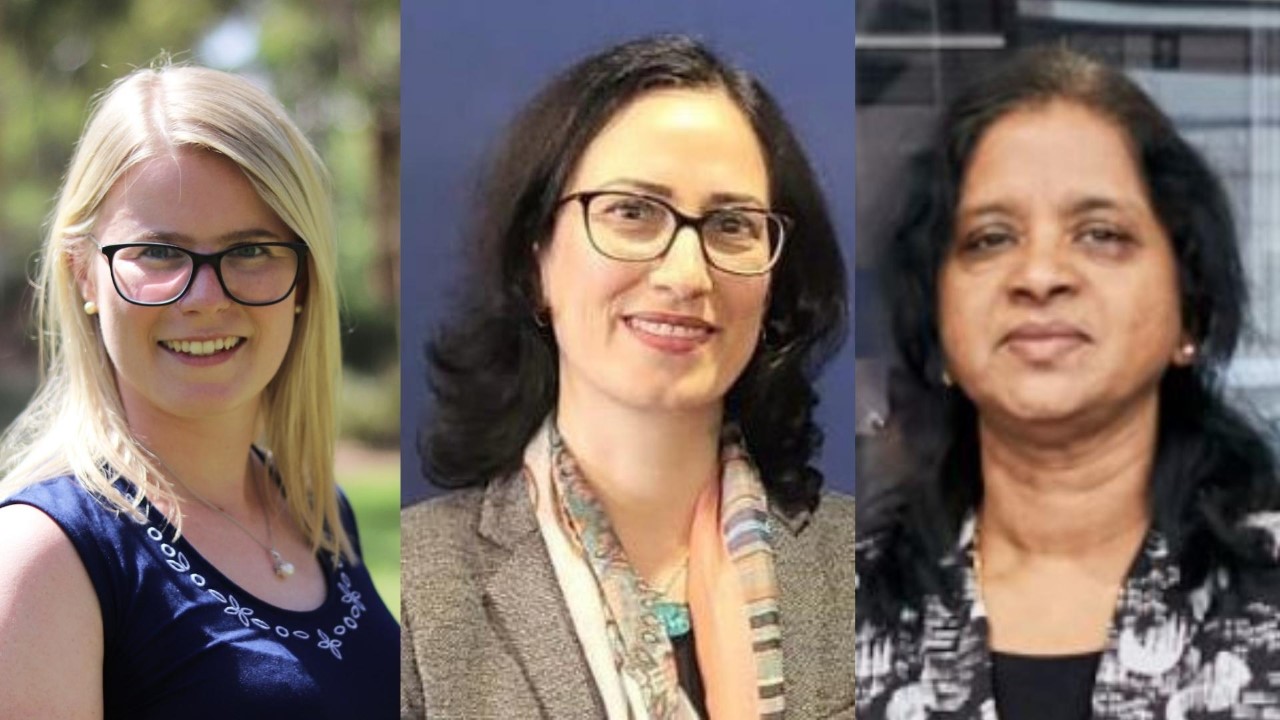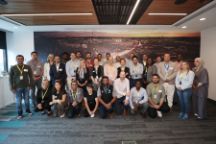Honouring Swinburne engineers this International Women in Engineering Day

Victoria Zinnecker, Associate Professor Mahnaz Shafiei and Shanti Krishnan.
In summary
- Victoria Zinnecker is a Aerostructure Innovation Research (AIR) Hub Research Fellow.
- Associate Professor Mahnaz Shafiei is leading pioneering work on next generation miniaturised, low-power gas sensors for practical uses in health and environmental monitoring.
- At Swinburne’s Factory of the Future Shanti Krishnan is helping industries innovate and embrace technology through her passion for making engineering interesting.
Australia’s engineering skills shortage has reached a 10-year high, exacerbated by the impact of COVID-19.
On top of the general shortage, the profession is suffering from a critical gender imbalance, with Engineers Australia reporting only 12 per cent of engineers in the country are women.
This International Women in Engineering Day, Swinburne University of Technology pays tribute to women who have followed their passions in engineering, overcoming the many barriers women face in forging successful careers in the field.
Why equality in engineering matters
The Workplace Gender Equality Agency says that gender imbalance, anywhere, affects us all. Gender equality is associated with improved productivity, economic growth, organisational performance, ability to attract and retain employees, and enhanced organisational reputation.
Swinburne has long been a champion of workplace gender equality and is building gender equity and diversity in science, technology, engineering, maths and medicine (STEMM), by participating in the Science in Australia Gender Equity (SAGE) program.
When asked what it will take to get more women in engineering, our Swinburne female engineers put it down to three things: mindset, early education and engagement.
These women have all been instrumental in engaging the next generation of female engineers through early education initiatives, as a nod to the impact it has had on them. They have played key roles in assisting with and hosting an array of activities, events and workshops to demonstrate that STEMM is exciting and interesting and can be a rewarding and versatile career choice for girls and women.
Meet some of the inspiring women from Swinburne who are making waves in their respective fields.
Victoria Zinnecker
Aerostructure Innovation Research (AIR) Hub Research Fellow, Victoria Zinnecker leads research and development with one of AIR Hub’s partners, Boeing Australia.
Her team develop intelligent manufacturing processes for aerospace components that Boeing then applies in the production of parts for their aircraft wings.
Victoria credits her German upbringing and awareness of household names like Bosch and Voith – companies with fantastic technical solutions and products – for sparking her interest in engineering. Throughout primary and secondary school she explored this interest and participated in programs aimed at engaging students to participate in STEMM learning, such as trying the basics of welding or coding.
She thinks that for more women to get into engineering it comes down to ‘mindset’ and opportunity.
“The ability to problem solve, optimise and implement is central and these have nothing to do with gender. Some of the most successful outcomes I’ve seen have been from constructive conflict and the most diverse teams. To get meaningful change, the emphasis should be on access to genuine role models and leaders and career support rather than filling quotas,” she said.
Victoria is passionate about engaging the next generation of women scientists, hosting and volunteering across several engineering workshops.
Associate Professor Mahnaz Shafiei
“I became an engineer because of my intrinsic motivation and a love of maths and art. I have always liked art, and engineering involves the art of design, creativity, and technology! Being an engineer gives you opportunities to use your creativity every day! My dad is also a good “hands-on” engineer so perhaps it’s in the genes,” Mahnaz Shafiei.
Associate Professor Shafiei is a Vice-Chancellor’s Women in STEMM Fellow and Associate Professor at Swinburne.
Mahnaz is leading research that focuses on a fundamental understanding of nanomaterials suited to the development of next generation miniaturised, low-power gas sensors for practical uses in health and environmental monitoring.
Sensor technology is an important enabler in modern society for detecting, monitoring and managing specific gases or liquids in our natural and built environments. A revolutionising technological trend is the rapid growth of mobile sensors for personalised health evaluation, environmental monitoring, robotics and security. Mahnaz and her research team are investigating new technologies to develop reliable, portable gas sensors to be embedded in sensor nodes for Internet-of-Things applications or for mobile systems (trucks, trains, industrial sites).
Recently, Mahnaz’s team focussed on the development of high-performing sensors for detecting hydrogen in a range of end-use applications.
On a day-to-day basis, some lucky people in Australia and overseas are already driving hydrogen-powered cars or moving from place to place with a fuel cell, hydrogen-powered, bus or train. These transport vehicles exhaust only water and zero carbon dioxide. In these practical environments, as well as in industries that use hydrogen as an energy source or as a key chemical, safety through rapid and effective detection of hydrogen (or other combustible gases) is a key requirement.
While existing technologies provide adequate detection, Mahnaz’s research aim is to deliver higher performing and lower cost sensors to enable many more diverse applications that use hydrogen as we transition to a green, or clean, energy industry.
Shanti Krishnan
Shanti is the Deputy Director of the Factory of the Future at Swinburne, and also a co-founder of Swinburne spin-out technology company mDetect, which specialises in using particles from space called muons to see the unseeable. Her primary focus is to de-risk innovation for industries and enable them to embrace technology. It is also her passion to make engineering interesting to students, as she believes we have a wealth of talent in young Australians, waiting to be tapped into.
“I have always been fascinated by robots and machines. I always wondered how high-powered instruments like telescopes and satellites worked, and even today, when I see videos of a satellite launch or automated cars negotiating in traffic, I am awestruck and wanting to learn more. This curiosity has followed an engineering pathway to where I am today,” Shanti said.
What do we need to do to get more women in engineering? Shanti says that we need to break stereotypes and remove the myth that engineering is not suitable for women.
“Through STEMM workshops for women, where the participants get an opportunity to get their hands dirty and see their own engineering creations spring to life, listening to inspiring talks by the great women engineers today, women can become motivated, relate to others and take action.”
Amongst Shanti’s list of achievements, last month she and her team completed a project for a human blood processing centre, using collaborative robots, Internet of Things and smart sensors. As a result, the project is improving work, health and safety outcomes for staff, improving quality outcomes and process KPIs, improved process data collection and digital upskilling of employees.
The project has been so successful, the medical industry plans to scale and commercialise this process potentially across Australia and international blood banks.
-
Media Enquiries
Related articles
-

- Technology
- Science
- Engineering
Victorian students drive green energy transition through international hydrogen competition
Swinburne’s KIOSC, in collaboration with Horizon Educational and Gippsland Tech School, co-hosted the Hydrogen Grand Prix in Melbourne.Friday 26 July 2024 -

- Education
- Engineering
Transforming the lives of refugee engineers through the EPIC Program
Swinburne has been partnering with the Level Crossing Removal Project (LXRP) on the Engineering Pathway Industry Cadetship (EPIC) program, helping refugee engineers gain international qualifications for the Australian workforce through an 18-month paid cadetship program.
Thursday 20 June 2024 -

- Science
- Engineering
Submarines in the future could self-identify cracks and self-heal thanks to Swinburne researcher
Thanks to the work of Dr Nisa Salim from Swinburne University of Technology’s School of Engineering, future submarines could self-identify microcracks and self-heal using a new kind of carbon fibre reinforced polymer composites.
Monday 17 June 2024 -

- Social Affairs
- Health
Swinburne leads world-first medical cannabis driving trial
Swinburne researchers are spearheading a world-first trial to evaluate whether patients can drive safely while on prescribed medical cannabis
Tuesday 28 May 2024 -

- University
- Engineering
Mechanical engineering gets a next gen_campus transformation
Swinburne University of Technology’s mechanical engineering facilities have been upgraded as part of our next gen_campus transformation.
Wednesday 15 May 2024

